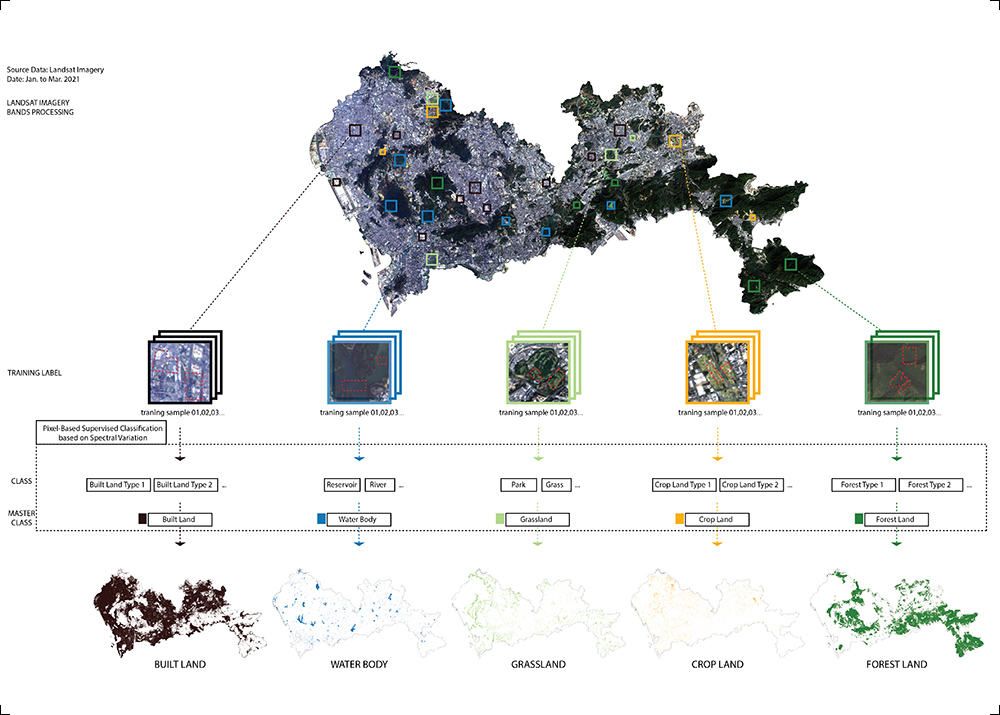urban breathing
Year: 2022
Size: 50 m2
Type: installation
Status: completed
Location: Shenzhen, Guangdong, China
Client: 9th Bi-City Biennale of Urbanism and Architecture (UABB 2022)
Partners in charge: Nicola Saladino, Chen Chen
Design team: Siqi Xiao, Javier Pelaez, Xinran Zheng, Chujie Lin, Zijie Tang, Yuhan Feng
Research Support: Energy Foundation Low Carbon City Group (carbon emissions); Meikang Li, Qiwei Song (Shenzhen urban landuse)
Carbon dioxide has always been a constant presence in human lives as we normally exhale CO2 while breathing, but in modern times we also emit more and more carbon as a byproduct of pretty much every daily activity and these emissions are the main cause of global warming.
Currently an average Chinese citizen produces 22.5 Kg of CO2 emissions per day and a mature tree roughly needs one year to sequestrate the same amount of carbon from the atmosphere. From this simple equation it is clear that no matter how energy-efficient our future cities become, only a massive green ecosystem can balance the emissions of the urban population.
Shenzhen is already among China’s greenest cities and its dense vegetation is not only beneficial for its urban biosphere, but it is also an efficient sponge for the CO2 emitted by its human inhabitants, thus allowing the city to breathe.
The installation Urban Breathing responds to a call from the 9th Bi-City Biennale of Urbanism & Architecture to explore “urban cosmologies”. Starting from a cosmological view on energy, the installation focuses on the city carbon cycle, visualizing in spatial terms the carbon emissions of an average inhabitant and relating them with the capture capacity of the urban green. The dichotomy human emissions / green capture is reflected by a constant alternation of two modes: inhaling and exhaling.
In a room of 7x7 m, four large balloons made of translucent membrane are constantly inflated and deflated by powerful fans. When they reach their maximum volume (11.5m3 each - corresponding to 22.5 Kg of CO2) they saturate the whole space of the room, virtually trapping the visitors in the center under the big stainless steel cone that reminds them of the industrial past of the venue.
Two projectors cover the visible surface of the balloons with an alternation of short clips of carbon-intensive human activities and a virtual journey through green systems. Electronic music with samplings of urban / natural noise and breathing creates an immersive multi-sensorial experience.
While the action takes place around the balloons, a map of Shenzhen on the main wall shows the duality of the carbon cycle: with normal lighting conditions the map highlights the population density, relating the individual scale of the room (one balloon = one person’s daily CO2 emissions) to the scale of the city, while under UV lighting all the green areas of Shenzhen start glowing with different intensities according to the capturing capacity of various types of vegetation.
The installation aims at solidifying something as intangible as a gas, and yet so critical for our future, into a physical presence that interacts with all the senses of the visitors, casting a light on our role as responsible individuals.
二氧化碳,是人类生活中的一部分。呼吸时,我们无时无刻都在呼出二氧化碳。在城市里,每一项日常活动几乎都会产生碳。大量的碳排放,也是全球变暖的主要原因。
目前,一个中国人平均每天会产生22.5kg的二氧化碳;一棵大树需要整整一年的时间,才能吸收同等数量的二氧化碳。从这个简单的等量关系看出,无论未来的城市变得多么节能减排,唯有庞大的绿色生态系统,才能平衡城市人口产生的大量碳排放。
深圳,是中国最绿色的城市之一。深圳的茂密植被,不仅对生态系统有利,同时也是碳吸收的海绵体,让这座城市得以“呼吸”。
临界工作室的作品《呼吸城市》,尝试对第九届深港城市建筑双年展(深圳)的主题“城市生息”作出回应。从能源的宇宙观出发,《呼吸城市》以装置的形式关注城市的碳循环——将一个普通人日常生活的碳排放可视化,并与城市植被的碳吸收建立关联。装置尝试利用“呼气”和“吸气”的方式,模拟碳循环的过程。
在7米×7米的展厅内,四个由半透明膜制作而成的气球柱,在内置风扇的作用下交替“呼气”和“吸气”。“吸气”模式下,每个气球的体积将达到11.5立方米,相当于一个中国人每天产生的22.5kg二氧化碳的体积。充满气的气球,占据了展厅的整个空间,观众被“困”在啤酒厂设备的不锈钢锥体下方。
气球柱的表面,循环播放碳密集型的城市生活和绿色自然的短片。短片的背景音乐里,城市噪音、自然界的声音和呼吸采样的电子音乐,共同创造出一种身临其境的体验。
展墙上的深圳地图,在不同的照明条件下,呈现出两种不同状态。普通照明时,地图显示深圳这座城市的人口密度——结合一个气球相当于一个人每天的二氧化碳排放量的直观体验——将展厅内的装置,与深圳这座人口规模将近两千万的城市建立关联。紫外线照明时,根据不同植被的碳吸收能力,地图上的植被呈现出不同强度的亮光。
气体看不见、摸不着,但它们对人类的未来却有着如此关键的影响。该装置的目的在于,将无形转化为有形,与参观者的多种感官互动,唤起每个人对碳更多的认知,继而行动起来。







